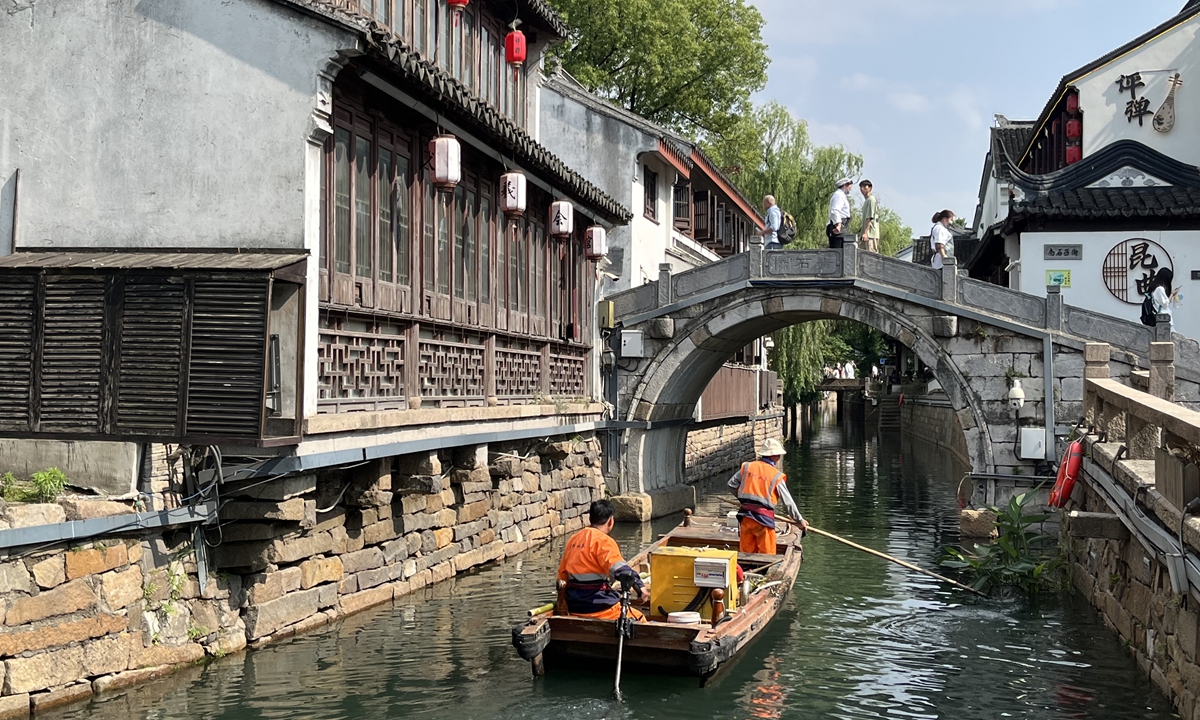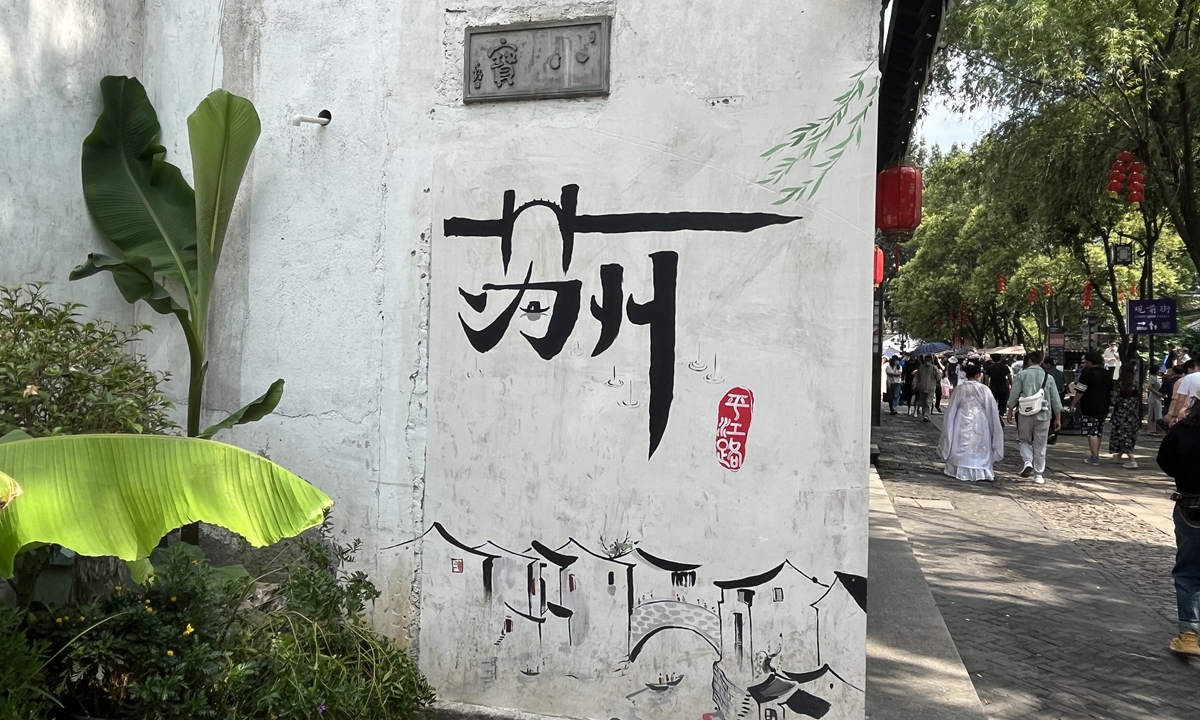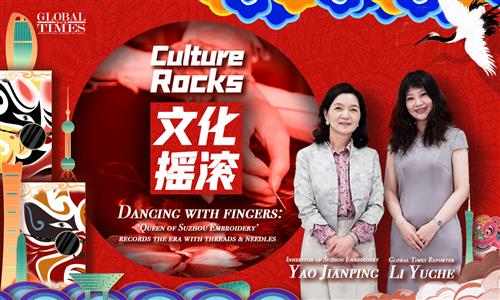ARTS / CULTURE & LEISURE
Suzhou, paragon of China’s ancient towns, retains its historical and cultural charm
‘Venice in the East’

A boat cruises down the waterway at Pingjiang Road in Suzhou, East China's Jiangsu Province. Photo: Xu Liuliu/Global Times
The ancient Pingjiang Road is one of the top tourist attractions in Suzhou, East China's Jiangsu Province, as seen from the crowds of visitors during the ongoing summer vacation. It is a well-preserved ancient block of Suzhou's old town, whose rejuvenation in recent decades is a paradigm of China's drive to push urban renewal while still preserving its cities' cultural roots.In urban planning and old town preservation, especially for a 2,500-year-old city like Suzhou, "preserving the old as the original" principle is "actually a way to protect the characteristics of the city's cultural heritage," rather than an endeavor to give it a "modern aesthetic look," Wu Yongbo, an urban planning expert, told the Global Times on Sunday.
Chinese President Xi Jinping inspected the city of Suzhou a few days ago. On his itinerary was the historical and cultural block of Pingjiang Road, where he learned about the city's efforts in historical and cultural protection.
Xi watched Pingtan (storytelling and ballad singing in Suzhou dialect) and appreciated the Suzhou embroidery artworks along the road.
Shan Jixiang, head of China Cultural Relics Academy, praised Suzhou's decades of hard work for breathing new life into the ancient city while painstakingly preserving its antiquity.
"Suzhou has explored a lot of beneficial experience in the inheritance and protection of historical culture," he said.
Trailblazer of preservation
With a history of 2,500 years, Suzhou is referred to as one of the heavens on earth in a famous Chinese adage. Interlaced with rivers and peppered with traditional gardens, the layout of its old town remains largely unchanged from a painting drawn in the Song Dynasty (960-1279).
Walking down Pingjiang Road, you feel like you have traveled back in time a few hundred years, back to the Song Dynasty when the road was already paved, just like it is today. The water in the river is still green and clear and residents roam around the area as they used to during the Song Dynasty. The Venetian traveler Marco Polo, who first visited Suzhou in 1276, called it "Venice in the East," smitten by its crisscross canals and prosperity.
The place seems frozen in time and offers a great scene for traditional Chinese painting as the city is a trailblazer of old town preservation in China. In 1950, shortly after the founding of the People's Republic of China, a committee was set up for the protection of Suzhou's cultural relics.
In the 1980s and 1990s, Suzhou adopted the approach of preserving the old while developing the new. Local authorities also started piloting renovation projects for the old town.
Since 2012, the old town of Suzhou has significantly expanded its protected area, encompassing more historic buildings, from schools to old factories.
Wu said that it is "actually much more difficult" to repair the historical cultural district as "the original" than to "tear them down for renovation."
Planned with scientific wisdom
While wandering along Pingjiang Road, visitors can appreciate the ancient buildings lining the roadsides, as well as the ancient stone bridges and the small boats cruising along the waterway. Instead of walking, many tourists like to take a boat trip to enjoy a more leisurely experience.
As an ancient street, Pingjiang Road has undergone several rounds of protection and renovation, but the main focus has been on restoring the buildings that line the street to their former glory.
Many of the old houses along the road have had their old looks preserved but have been converted into bars and clubs, blending in well with the vibe of the whole area. Behind the traditional wooden doors, visitors can discover many surprises in their modern-day use.
Traditional Chinese theaters and tea houses can also be found along Pingjiang Road, where visitors can take a rest and enjoy a cup of tea while listening to Suzhou Pingtan performances.

A scene at Pingjiang Road in Suzhou, East China's Jiangsu Province Photo: Xu Liuliu/Global Times
In 2020, a thorough survey was launched to examine and register every house, well, bridge, and tree in the old town's 54 residential communities, with the aim of providing more accurate data for future protection.Ancient bridges, wells and water alleys in Suzhou are most concentrated in the district.
Wu believes that the district's 2,500-year-old "inherited scientific planning system" has been an inspiration for the current strategy.
In 2022, the Pingjiang Road Historic and Cultural Block was designated a national-level tourist leisure zone.
"The reason why the district can achieve this is because its own building system has gradually become scientific in the advancement of history, so the restoration work is more focused on the protection of historical objects," Wu said, and he added that the 8,000 residents still living on the street have made its "historical and cultural value more prominent."
"Generations of residents living here keep the district historicity alive in their everyday lives," Wu said.
Wu pointed out that the architecture of Suzhou city's unique classical gardens can also adapt to the "repairing the old as the original" strategy.
"Compared with Western countries' stone buildings, Chinese brick and wood buildings, especially wooden structures, need more preservation effort, which is one of the reasons why China pays so much attention to the protection of urban cultural heritage," Wu said.




